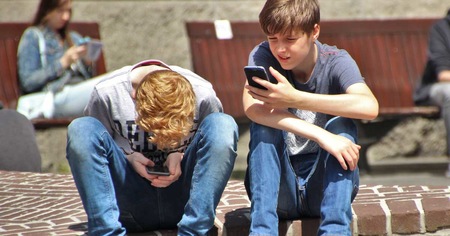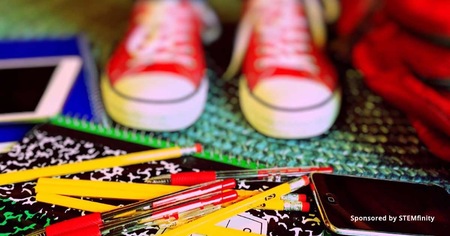To prepare young people for their futures, effective hands-on STEM education needs to involve activities where youth work together to solve problems, answer questions and discover content. Collaboration prepares them with the skills they will need for their careers. It allows programs to engage in more equipment-intensive projects and aids young people in the development of social-emotional learning skills. Unfortunately, STEM resources rarely address how to successfully manage collaborative activities.
Here are a few tips to help you encourage more collaboration within your activities.
Play Games!
Collaboration involves working as part of a team. A fantastic low-stress way to develop teamwork is to simply play games. Games are fun and will help young people understand the benefits of collaboration while demonstrating what successful collaboration looks and feels like.
Not every game will work. You need to choose games that are cooperative, rather than competitive, and games where young people support one another and are the primary decision makers. Games you choose should encourage youth to work together to solve challenges by discussing various strategies, communicating their ideas and putting their plans into action. Cooperative gaming helps develop teamwork and can help establish a positive learning environment.
Examples of collaborative games:
• All Aboard
Use a length of rope to form a circle on the floor that is large enough for all young people to stand inside. Invite everyone to stand in the circle and congratulate them for fitting. Ask young people to step out of the circle and make it smaller. Invite them all to step into the circle again and try to fit. Continue in this manner—making the circle smaller each time they step in and out. Encourage them to work together and be creative, to find ways for all to fit in the circle each time it becomes smaller.
• Birthday Mimes
Challenge young people to line up chronologically according to their birthdays, with the caveat that no one can talk. They will need to work together to determine a way to communicate the information they need to know, to complete this challenge.
• Zoom
Have young people form a circle and give each person a unique picture of an object, animal or whatever else suits your fancy. Begin telling a story and incorporate the object from your picture into the story. Have youth take turns adding to the story and incorporating the object on their pictures during their storytelling.
Choose Me!
One of the biggest challenges in having young people collaborate is organizing mixed groups who trust one another and work well together. When forming groups, consider the personality of each youth and carefully choose the participants of each small group. You want to avoid groups devolving into dictatorships—in which one person steers the project and everyone else just follows—or having one member of the group coast along without doing any work.
Use medium-sized groups of four to five youth, to maximize the effectiveness of collaboration. There is room for youth to hide in large groups, and small groups can lack diversity and lead to single-minded thinking.
Set clear goals and milestones of completion to aid groups. Bestow everyone with a high degree of individual accountability by assessing their work both as a group and individually. Have youth evaluate their own contributions and efforts at the end of an activity.
Pulling together!
Work to ensure everyone has a voice when starting collaborative activities: Give each group member a role.
Roles can be given out in a random draw, injecting some fun into the proceedings. Be wary, however, when choosing roles: Make sure they are meaningful and will relate to the content of the activity. Roles such as timekeeper and record-keeping can devolve into busy work and may not intellectually engage the assignee. Look to assign roles with responsibility, such as manager, sub-task leader, researcher and public relations coordinator. Meaningful roles give young people ownership of the process and allow for assessment based on successful completion of these roles.
Speak Up!
Working together successfully involves learning how to be part of a group and how to communicate effectively within that group. Good interpersonal communication is an essential skill to develop. Train young people how to have meaningful conversations by introducing the rules of collaborative conversation. Giving them specific language to articulate their ideas is a valuable investment.
A few examples for higher-level, meaningful classroom conversation may be found at https://www.teachthought.com/critical-thinking/sentence-stems-higher-level-conversation-classroom/.
Conflict!
Conflicts and disagreements will occur. It is important to guide young people how to successfully resolve these issues.
Youth need to understand that debate is part of a healthy collaborative process. A debate, when constructive, can help to boost creative thinking and generate new ideas. The goal should not be to eliminate conflict, but to supply youth with the skills to deal constructively with the conflict and each other. Outline and model respectful ways to raise counterpoints and ideas. Teach young people that all opinions need to be heard. A different point of view may help you see the problem in a new way and develop a better solution. To help develop these skills, have youth hold a mini-debate on a locally relevant real-world issue. Discuss the ground rules and expectations for the debate with youth. Design and post a chart of acceptable and unacceptable behaviors. Outline the procedure for when someone is not listened to, or if a group reaches an impasse. Teach young people to understand that they all have accountability and operate with shared leadership when working together.
Live in the Real World!
Pick activities that will be relatable to young people, to increase their participation. These activities can be tied to STEM initiatives occurring in the area or to content they are learning about. Ensure tasks are complex, so there is a reason to collaborate. A task that is too simple can be done alone, eliminating the need to collaborate. Youth might only interact with the content in superficial ways if a task is not relatable.
In the real world, we collaborate when a task is complex or difficult and has too many pieces to complete alone. Relatable contexts and challenging questions encourage higher-order reasoning. Choose assignments that allow room for varied interpretations. For example: Ask small groups to question if ranchers should be able to hunt around Yellowstone National Park. Groups will need to research the environmental impact of wolves in an ecosystem and contrast that with the economic realities of local ranches. Through research, discussion and debate, each group needs to develop their ideas to conclude with a solution they propose and defend together.
Be Active!
Many collaborative activities fall apart when the facilitator takes the opportunity to catch up on other work and only gets involved if the noise level rises. You need to actively facilitate group interaction, for collaboration to be successful. Offer encouragement and guidance, and ask questions to keep everyone moving forward. Use a scaffolding approach when facilitating: Give more direction at the start of the activity and lessen it as you continue toward the end of the activity.
Collaboration has come to define modern STEM education. When done well, collaborative projects allow young people to foster innovation, clarify ideas and develop solutions. By implementing collaborative projects, you will encourage youths' STEM development and provide them with a healthy dose of social-emotional learning they can utilize in all avenues of their lives. Youth will learn how to trust, communicate, debate and resolve conflict through collaboration.
As with other worthwhile endeavors, you cannot wave a magic wand and have effective collaboration. Both young people and you will need to practice.
Have fun!
Written by Andy the Science Wiz, NAA STEM Specialist, Andy Allan.




